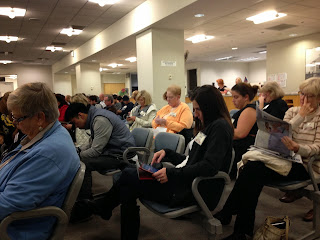 |
| Joyce Maynard on the far right. |
Joyce Maynard just got married.
This past May I attended Joyce's writing workshop at her home in Mill Valley about 20 minutes north of San Francisco. It was a day long affair where Joyce, along with seven of us, reviewed and commented on our manuscripts. While having lunch on her deck, which overlooks Mount Tamalpais, she pointed out the regrettable reality that her fame is too closely tied to the fact that she lived with J. D. Salinger – the recluse author of
The Catcher in the Rye – for the better part of a year while writing her first book. Prefacing her bio with this makes it seem she's riding Salinger's coattails which couldn't be further from the truth. Her initial fame, that caught the eye of J. D. Salinger, was a feature article she wrote for The New York Times magazine,
An 18-Year-Old Looks Back On Life, while a freshman at Yale.
 |
| Joyce Maynard's kitchen. |
I've never attended a writing workshop before Joyce's. Although I've published paid and unpaid journalistic articles, interviews, and blog posts, I wanted to work on improving my writing ever since sticking my toe in the waters of fiction writing, last summer. Although Joyce has written fiction, her true talent is the personal narrative.
I don't recall exactly how I discovered Joyce's workshop other than it percolated to the top of my Google search results. I sent off an e-mail to Joyce with great timing. She promptly responded even though she was at her rural place in
Guatemala on Lake Atitlán for her ten day writing workshop with limited Internet access. After a few e-mail exchanges I was signed up for her May workshop.
Joyce taught me more about writing in one day than I had learned anywhere else.
Joyce showed me how to quickly detect when there's a story to be told:
"I used to do ________ but now I do ________."
Every time I filled in those two blanks with my real life experiences I had a story to tell.
 |
| My manuscript autographed by Joyce Maynard. |
A key point she taught me was to write personal narratives that only I could write. She said, "Don't be a reporter. Tell the story that only you can tell." This concept was new to me since much of my paid writing was exactly that: reporting. Very quickly, with each one of us at her workshop, she could figure out the story behind the story. As I listened to each writer's backstory I noticed myself leaning in to hear more. As Joyce asked me a few questions about my manuscript I realized where my deeper, more personal, and interesting story really was. She even gave me a resounding opening line for my manuscript rewrite.
I clearly understood her lessons; especially about how we should use symbols in our writing. Her biggest point that hit home with me was to write less, not more, much like my favorite author, Ernest Hemingway. Leave out small, unimportant details, and let your reader conclude how to get from point-A to point-B. The idea isn't to shut out your readers, but leave out just enough to pull them in like a mystery novel.
At the workshop, Joyce told me about her upcoming wedding plans and I've been following her
updates ever since.
 From a technical point, there's no way that HealthCare.gov (Obamacare) could have rolled out successfully.
From a technical point, there's no way that HealthCare.gov (Obamacare) could have rolled out successfully.










































